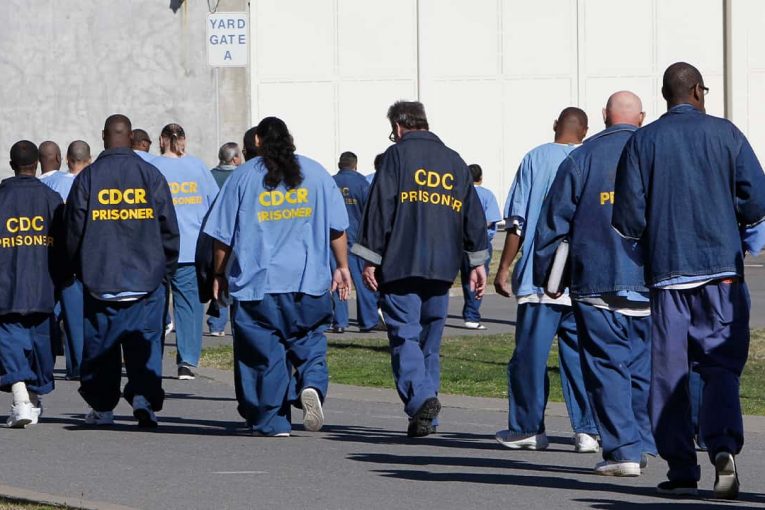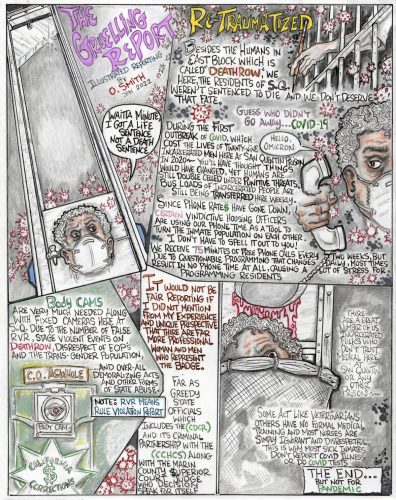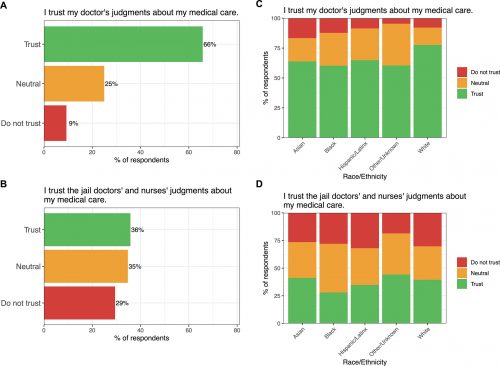
This report is written by the Covid In-Custody Project which partners with the Davis Vanguard to bring reporting on the pandemic in California’s county jails and Department of Corrections and Rehabilitation (CDCR) to the public eye. Visit our website to view and download our data on cases, testing, releases and vaccinations for incarcerated people and staff.
By Cassie Gorman
“I still have not received the ‘jab’ [COVID-19 vaccine] and have no plan to as long as I’m incarcerated,” writes Orlando Smith, who is incarcerated at San Quentin State Prison, in a correspondence with the Covid In-Custody Project in late April this year.
“Why, you ask?” Smith continues. “I don’t trust these people [officials] at all. My health is NOT their concern.” According to Smith, at the time of writing his letter, San Quentin had been placed under a new wave of quarantines due to exposures to COVID-19.
As of May 2022, the vaccination rate in California’s prison system is nearly 18% higher than the national rate. The work that medical staff, public health officials and incarcerated people have put in to achieve a vaccination rate of 84% in the prison system is commendable. But despite these efforts, a distrust of prison officials and a widespread proliferation of COVID-19 misinformation hold some incarcerated people back from getting vaccinated.
The Covid In-Custody Project spoke with several people in California’s prisons about their thoughts on the COVID-19 vaccine. Here is what we learned.
Lack of trust between prison officials and incarcerated individuals
Orlando Smith remarks that his hesitancy about getting vaccinated stems from a pattern of San Quentin’s prison staff acting neglectfully. He references non-COVID-related conditions brought on by the institution, namely double ceiling, the practice of housing two people in a cell built for one, to illustrate what he feels is a long-standing pattern of staff neglecting the well-being of incarcerated people that goes beyond the pandemic.
In a letter to the Covid In-Custody Project, Brandon Baker, who is incarcerated at Los Angeles County Prison, stated that some people in his facility are afraid to take the vaccine because they believe the administration may have a plan to kill or experiment on them.
The sentiment of fear and distrust of staff is widespread, going beyond just Brandon Baker and Orlando Smith, and evidenced by surveys conducted by the Marshall Project and the Correctional Association of New York.
In early 2021, at the beginning of the vaccine rollout, the Marshall Project reported that nearly 50% of the 136 residents surveyed in state and federal prisons said they do not believe the prison is acting in their best interest by rolling out the vaccine. They posed the question: if staff have not cared for them in the past, why would they now?
“I don’t have a lot of faith that people actually care about my well-being,” said James Ellis, one of the survey respondents. “Most think guys in prison are the scum of the earth, so it’s hard to feel good about people who think that low of me, and it’s hard to believe they are actually doing something for me that’s in my best interest.”
A survey conducted by the Correctional Association of New York (CANY) in 2021 uncovered similar patterns. Nearly 42% of the 200 respondents in New York’s jail and prison facilities reported being less likely to consent to being vaccinated if the vaccine was administered by correctional staff.
A third of respondents in the Marshall Project’s survey also indicated a fear that the vaccine rollout may be part of an attempt to experiment on the incarcerated population. They cited past events, like San Quentin’s testicular experiment in 1918 and the forced sterilization of 150 incarcerated women in California from 2006 to 2010.
Though prison medical practices are far more regulated now, these historical examples are still influential on modern perceptions of the institutions. Smith, a recognized artist, depicted his perception of prison conditions and distrust of prison staff in “The Grueling Report Issue 5: Re-Traumatized,” published April 2022.

Jermain Archer, who was incarcerated in the New York state prison system, reported similar experiences as Smith. In a video series published in May 2021 by The Marshall Project, Archer stated that incarcerated people trust each other more than staff, and consequently avoid reporting symptoms and choose to care for themselves while sick.
If incarcerated individuals feel they cannot trust those whose job it is to protect them, who do they trust?
Misinformation about COVID-19 vaccines
Prior to the COVID vaccine rollout, the Center for Disease Control (CDC) reported that the most common misconception incarcerated people had about the vaccine was that it is unnecessary since herd immunity and natural antibodies would be sufficient to fight the virus. The CDC’s survey of roughly 5,110 incarcerated people in institutions across the U.S. also revealed that roughly 75% of vaccine-hesitant respondents had concerns about efficacy or safety or were waiting to see others vaccinated.
Unfortunately, recent surveys suggest that COVID vaccine hesitancy, specifically hesitancy that arises from misinformation about the vaccine, has not dwindled.
Since incarcerated people have restricted access to the media, their friends and family are their main source for information on COVID. Staff members also have an important role to play in vaccine education.
Patrick Stephens, incarcerated at Sing Sing Correctional Facility in New York, told The Appeal in April this year that he has heard both correctional officers and residents say that the virus is harmless, the vaccine is a government experiment and that the pandemic is a government attempt to control population growth.
“One unsubstantiated COVID-19 claim seems to feed the next until whole conspiracies are concocted and reinforced out of thin air,” Stephens writes. He notes that although some do not believe the misinformation, it still prompts hesitancy.
Incarcerated individuals also have little to no internet access and news outlets are a common source of information in correctional facilities. In a correspondence with the Covid In-Custody Project, Brandon Baker noted that he has access to basic news channels, including those espousing right-leaning views.
“While people in society have internet access and the ability to do their own research, the incarcerated population doesn’t have the same liberty,” Baker notes in his letter.
He reports having received encouraging information about the vaccine from a fellow resident who is in contact with a friend in healthcare (who is employed outside the institution), and this influenced his decision to get vaccinated.
“I’ve heard things like, ‘The vax is for wimps, Covid is just like the flu,” notes Baker in his letter. He continues, “The problem is deeper than the virus, it’s a culture that is engraved in the DNA of prison… The male COs [correctional officers] are viewed as real men, and the tough looking criminals are viewed as wimps for getting the vaccine.”
Across all institutions in the CDCR, 71% of staff members are fully vaccinated, a lower rate than that of the incarcerated population.
“Why should someone trust the vaccine if the people forcing the vaccine aren’t vaccinated?’” Baker rhetorically asks.
Moving Forward
A majority of vaccine-hesitant respondents, in a study published by the Stanford School of Medicine, said they would get vaccinated if their questions about the vaccine were answered, if their friends and family said it was safe or if guards were inoculated first. The question remains, what has worked to circulate scientific information from trusted sources in prisons?
San Quentin State Prison posed the same question, and last May, the media department brought in healthcare professionals from the University of California, San Francisco to answer residents’ concerns about the development of the vaccine, overall safety and the possibility of negative side effects.
San Quentin News reported that after the Q&A session, several incarcerated people who were previously hesitant felt comfortable getting inoculated. Among them was Jesse Rose, who told San Quentin News that having his questions answered caused him to rethink his stance, and he received his vaccine following the Q&A session.
The success of consulting outside professionals in addressing concerns is supported by data showing that incarcerated individuals tend to trust doctors from outside the institution greater than CDCR doctors. A survey of 2,564 jail residents in Northern California conducted from December 2020 to April 2021 showed that 66% of respondents trusted outside medical staff, while only 33% trusted staff within their jail.

This pattern is seen in other institutions, as 49% of respondents to the aforementioned survey conducted by the Correctional Association of New York report trusting the judgements of doctors outside their institution, while only 9% report trusting the judgements of staff within their institution.
It’s clear that other more trusted sources of information must be utilized, and many alternative tactics have been proposed or piloted.
John J Lennon, a writer incarcerated at Sullivan Correctional Facility in New York, wrote about his experience witnessing vaccine hesitancy in May 2021, and he suggested that prison officials recruit influential and well-liked incarcerated individuals to help spread accurate COVID-19 information to others.
Other organizations and programs have also thought about how to disseminate accurate information to those behind bars. In 2019, Lawrence Bartley, who was formerly incarcerated in New York’s state prisons, created News Inside, a print publication distributed across carceral institutions in the U.S.
“I know the frustrations of a hungry mind in prison,” Bartley writes in a piece announcing the launch of the publication. “News Inside is my attempt to feed that hunger with credible information about the world of criminal justice—free of charge and free of hassles.”
Issue 7 of News Inside, published in April 2021, contains an article called “What People in Prison Need to Know about the COVID-19 Vaccine,” answering questions about the vaccine from incarcerated people around the country. Issue 4, published in May 2020, includes “COVID-19: A Survival Guide for Incarcerated People.” Articles are co-authored by doctors associated with the University of California, San Francisco.
Amend, a public health program at the University of California, San Francisco, has created several FAQ sheets regarding COVID-19 and vaccines, posting them on bulletin boards in prisons throughout California as conditions surrounding the pandemic have evolved.
Though there have been many efforts to educate incarcerated people about the vaccine, there lacks a uniform educational program across all institutions in California or the U.S., one aimed at arming incarcerated individuals with the information they need from sources they trust.
Without this, misinformation and a distrust in prison staff will continue to hold incarcerated people back from protecting themselves against the virus.
The COVID in-Custody project extends a heartfelt thank you to Orlando Smith, Brandon Baker and Kevin Sawyer, whose communication with the COVID in-Custody Project made this piece possible.
Additional reporting by Claire Beckwith




